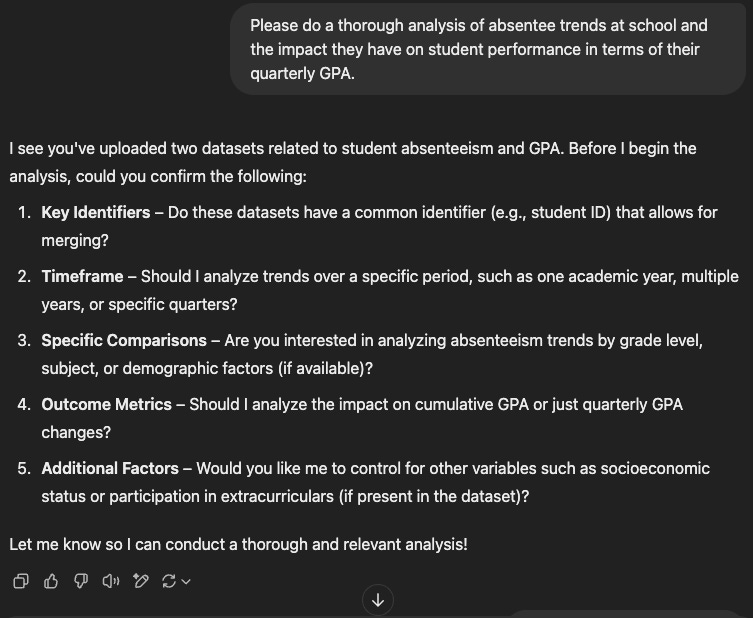From Data to Insights: How OpenAI’s Deep Research Can Transform School Decision-Making
So Many Questions, So Little Time
If you’re an independent school leader, you probably have a list of “I wonder” questions about your school. Are our attendance policies affecting student performance? Which programs improve student retention? What factors predict success in AP courses? These are fascinating questions – the kind of insights that could drive better decisions. The problem is finding the time to dig into the data and answer them. Most school administrators are swamped with day-to-day responsibilities, leaving little room for laborious data analysis. Our schools are swimming in valuable data, but we are often unable to make use of it due to limited time and capacity. The desire to be data-driven is there, but the hours required to crunch numbers and comb through spreadsheets are hard to come by.
Meet OpenAI’s Deep Research – Your AI Data Analyst
Imagine having a tireless research assistant who can analyze both your internal school data and the vast information on the web, then deliver answers in a clear report. OpenAI’s Deep Research does precisely that. It’s a new tool designed to take a research question and do all the heavy lifting for you – quickly and thoroughly. Unlike a standard chatbot, which might give you a quick one-shot answer, Deep Research actually “breaks down complex queries into smaller steps, searches the web, analyzes documents through multiple passes and synthesizes the information into comprehensive reports.” In other words, it acts like a skilled analyst: gathering data, cross-checking facts, and building a well-reasoned answer with evidence.
What’s especially exciting for schools is that Deep Research isn’t limited to public information. You can securely feed it your internal data – exports from systems like Veracross or Blackbaud (common platforms for student information and learning management in independent schools) – and ask it to analyze that data. If you have one of ChatGPT’s secure accounts (Enterprise, Edu, Teams, or you have appropriately managed your settings to turn off data training), all of this happens with your data remaining private; Deep Research will use the data you provide without exposing it to anyone else. Since many independent schools use modern School Information Systems (SISs), it is now easy to query the data that you are interested in analyzing. For example, a school leader could ask, “How do our students’ attendance rates compare to national trends, and is there a link to their academic performance?” Deep Research can look at your attendance records and find relevant studies or benchmarks on the web, giving you a rich, contextual answer.
The best part: it’s fast and easy. You don’t need to be a data scientist or write complex queries. You pose your question in plain English, and the AI handles the rest. OpenAI’s Deep Research was built for exactly these kinds of in-depth inquiries, and it shines in scenarios where humans would normally spend days sifting through data.
A Concrete Example: Attendance vs. Academic Performance
Let’s put this into practice with a real example. One question many educators ask is the impact of student attendance on academic performance. We all instinctively know that missing class can’t be good for learning, but how big is the effect at your own school? Is there a critical number of absences after which grades really suffer? To find out, I set up a scenario using synthetic school data (fictional data that simulates real patterns). This way, I can demonstrate the process without using any actual student records.
Scenario: Suppose you have a dataset of student attendance (each absence recorded with its duration and reason) and another dataset of student GPA by quarter. You want to investigate: Does attendance have any impact on academic performance? And if so, what patterns or trends emerge? In the past, you might have handed this off to a data-inclined faculty member or spent your weekend exporting CSV files, creating pivot tables, writing formulas, and creating charts. But with Deep Research, you can do it in a single sitting. Here’s how I approached this question step by step:
Upload the Attendance and GPA Data: I fed Deep Research two datasets – one with each student’s absences for the year (total days missed, dates, reasons, etc.) and one with each student’s GPA for the four quarters of the year. This is as simple as attaching the files within the Deep Research interface. The tool accepts the raw data and is ready to analyze it. (In a real school setting, this could be an export from Veracross or Blackbaud. In our case, it’s a synthetic CSV file of attendance records and another of GPA records.)
Ask Deep Research the Question: Next, we prompt the AI in plain language. For example, “Please do a thorough analysis of absentee trends at school and the impact they have on student performance in terms of their quarterly GPA.” Deep Research will ask a clarifying question if needed (just as a human data analyst would). With the question understood, the AI goes to work: it combs through the attendance data, calculates total absences per student, and compares that with each student’s GPA. You can follow its reasoning and steps in a side window. Behind the scenes, it’s doing all the things we would do (and more): grouping the data, running statistical correlations, and checking for any outliers or other factors. We didn’t have to specify the method – the AI figures out an approach to answer the question effectively.
Receive Insights in Just 9 Minutes and 11 Seconds: This is where the magic happens. Instead of waiting days for a report, Deep Research processes everything in minutes (in my case, 9 minutes and 11 seconds, to be exact!). The result is a concise report of findings. For our attendance vs. performance query, the AI delivered clear insights. What did we learn? The analysis confirmed a strong trend: students who missed more school tended to have lower GPAs. In fact, those with minimal absences (fewer than 5 days in the year) had significantly higher average GPAs (around a B+ average) compared to those who had large numbers of absences. Students who missed more than 10 days saw their average GPA drop by roughly 0.7 points on a 4.0 scale, a substantial difference. The AI even highlighted a compelling detail: the drop-off in GPA becomes most pronounced once a student exceeds about 5–6 absences – suggesting that occasional absences might be manageable, but chronic absenteeism is strongly linked to lower grades. All of these insights were neatly summarized in paragraphs and could be backed up by charts or tables (which the AI can describe or generate as needed). And remember, this was all delivered in the time it takes to have a cup of coffee.
From Hours (or Weeks) to Minutes: Why This Is a Game-Changer
Think about what we just accomplished: a question that could have taken hours of manual work (gathering data, cleaning it, running analyses, creating visualizations, interpreting results) was answered in just a few minutes. Deep Research not only saved time, it provided a level of thoroughness that would be hard to match without a dedicated data team. As a human, you might have checked the obvious (overall correlation between absences and GPA) and then moved on. The AI, however, can tirelessly probe for additional patterns – for example, it might notice if certain absence reasons (like extended family trips) correlate with smaller drops in GPA than others, or if the impact of absences differs between 9th graders and 12th graders. This kind of multi-angle analysis is often out of reach for an busy administrator doing a quick once-over of a spreadsheet.
Having this kind of tool at your disposal can transform how you make decisions at your school. Instead of relying on hunches or waiting until year-end for an external report, you can get answers on the fly. Curious if a new schedule is affecting homework completion rates? Wondering which feeder middle schools produce the students with the strongest performance in 9th grade? With a tool like Deep Research, you could investigate each of these in an afternoon. This elevates your ability as a school leader to drive conversations with data. You can go into board meetings or faculty discussions armed with evidence that was previously too cumbersome to obtain. Ultimately, all of this empowers us to better serve our students.
It also shifts the culture to one where educators can ask “What does the data say?” and actually get an answer without delay. Teachers and department heads, not just data specialists, can engage in meaningful data inquiry. For example, a teacher could explore whether the new reading program is boosting literacy scores by uploading her class data and asking the AI for an analysis – something that might have been unrealistic due to time or skill constraints before. In short, Deep Research empowers decision-making based on facts rather than anecdotes or assumptions. And when decisions are grounded in real insights, the outcomes for students tend to improve.
Try It Yourself – Embracing the Future of School Analytics
OpenAI’s Deep Research truly feels like a game-changer for independent schools. It’s bringing capabilities that were once reserved for large districts with big analytics budgets right into the hands of any school administrator with a pressing question. By dramatically lowering the barrier (in time, effort, and expertise) to perform deep-dive research, it enables school leaders to finally tap into the wealth of data they already have. As we saw with the attendance example, questions that lived on the back burner can now be answered and acted upon swiftly. This means more informed policies, targeted interventions for students, and a stronger case when communicating with stakeholders about what’s working and what isn’t.
I encourage you to give AI-driven research a try with a question that’s been on your mind. Start with something manageable – maybe it’s analyzing admissions trends over the past five years, or seeing if there’s any connection between school library usage and student achievement. You might be pleasantly surprised at how quickly you get a detailed answer. Forward-thinking school leaders who leverage these tools will be better equipped to lead their schools with insight and confidence.
If you found this article helpful, consider subscribing to the Fullstack Educator newsletter for more practical insights on how technology and AI can elevate teaching and leadership.









